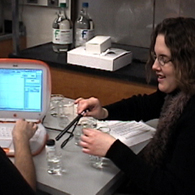|
|
|
|
Promoting inquiry through computer-based labs
|
|
|
Goals of the Lesson
- To introduce preservice secondary science teachers to computer-based laboratories (CBLs) as an instructional tool, which facilitates building inquiry-based instructional environments.
- To provide preservice secondary science teachers with some experiences with computer-based laboratories through using a variety of the Vernier probes and the associated hardware and software (LoggerPro®).
- To engage preservice secondary science teachers in inquiry-based science activities utilizing CBLs.
|
|
|
|
 |
|
|
Related Goals of Illinois Standards
The lesson relates to the following Illinois Professional Teacher Standards with special emphasis on technology:
Learning Environment
The teacher uses an understanding of individual and group motivation and behavior to create a learning environment that encourages positive social interaction, active engagement in learning, and self-motivation.
Instructional Delivery
The teacher understands and uses a variety of instructional strategies to encourage students’ development of critical thinking, problem solving, and performance skills.
|
|
|
 |
|
|
Tools and Equipments
- Laptops (one per group) with the LoggerPro software.
- Vernier probes (temperature, pressure, magnetic field, and conductivity) and interface boxes.
- Alcohol burners, ring stands, beakers, Erlenmeyer flasks, clamps.
- A set of seven solutions with increasing pH (e.g., 1, 3, 5, 7, 9, 11, and 14) and pH paper.
|
|
|
|
 |
|
Lesson Plan
- Several stations are set up with different probes and activities. For example, one station might feature an investigation of the boiling point of water using a temperature probe. Students could investigate the effect on the boiling point of a certain volume of water as different amounts of solutes are dissolved in the water. Another station would feature an investigation of the relationship between the pressure of a fixed volume of gas and its volume and/or temperature using the pressure and temperature probes. A third station would feature an investigation of the change in magnetic force as a function of distance using a magnetic field probe.
- Student teacher groups (groups of 2 or 3 depending on the availability of equipment) would rotate among stations and perform the aforementioned activities in a guided manner. This initial exposure is intended to familiarize preservice teachers with a variety of probes and the technology in general (the software, the interface, etc.), and help them build confidence and competence using the probes, and collecting and analyzing data.
- Next, student groups are asked to answer the following question: “What is the relationship between the pH and conductivity of a solution?” Groups discuss the question, formulate hypothesis, and produce a graphic representation of the hypothesized relationship. Often, several hypotheses are generated. Next, the groups collect data to test their hypotheses using solutions of varying pH, pH papers, and the conductivity probe. Next, student teachers use the collected evidence to evaluate their hypothesis. A whole class discussion follows.
- The session concludes with a whole-class discussion of CBLs, associated concerns, advantages, and venues for using this technology in the participant preservice teachers’ future classrooms.
|
|
|
 |
Evaluation
Student teachers performance on the last activity would help to gauge their mastery with using probes and associated software to collect and analyze data.
|
|
Videotaping
Instructor: Fouad Abd-El-Khalick
Course Number: C&I 302–S
Date: March 6, 2001
|
|
|
|
|
|
|
|
|
|
|
|
|




